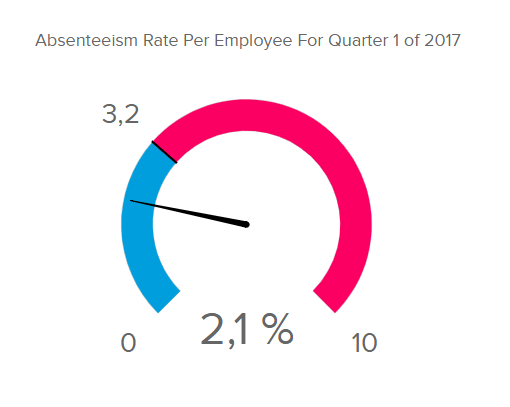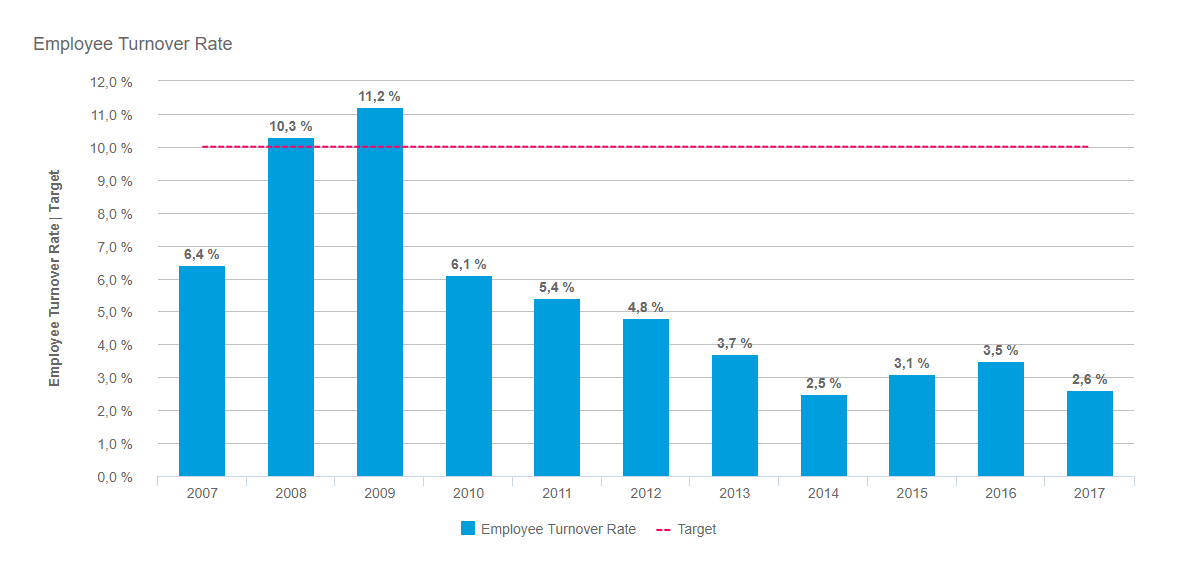How To Measure Employee Satisfaction For A More Fulfilling Workplace

Your company isn’t a psychologist’s office. It’s not a life coaching facility. It’s not a social club. So why does it matter so much that you have satisfied (aka happy and engaged) employees? The answer is simple. It comes down to cold, hard finances. Research supports the idea that companies that have satisfied employees have a major advantage over companies that don't. Satisfied employees:
- Are more productive
- Come to work more regularly
- Are less likely to leave for another job
How do you measure this engagement- or disengagement? How can you use these results, and measure their evolution over time? You can start by doing what most of other business departments in your company already do: tracking specific HR KPIs measuring employee satisfaction, and compiling and visualizing them through solid HR dashboards. Just like a lot of other business units, the human resources department is evolving into a data-driven function. This does not mean that the "human" aspect disappears, but on the contrary that it can better be assessed and the behavior, motivation, etc, can be followed and better taken into account. That will help your business make informed talent decisions, evaluate employees' performance and operate better workforce planning.
The application of business intelligence to Human Resources leads to the development of workforce analytics. More and more companies care about HR analytics and resort to data visualization software for their management, enabling them to produce a wide range of dashboards and reports, from workforce demographics and distribution to recruitment reports. But collecting data isn't helpful, as data is only valuable when it tells a story. To help you track the employee engagement metrics you want and take action, in this article we will answer two questions for you:
- How do you measure employee satisfaction?
- How do you improve workplace satisfaction?
By the end of this post, you’ll have actionable steps you can take in both of these areas.
Try our 14-days free trial & boost your employee satsifaction rates today!
How To Measure Workplace Satisfaction
Having to continuously hire and train new candidates is a very expensive process. People Keep states: “Some studies predict that every time a business replaces a salaried employee, it costs 6 to 9 months’ salary on average. For a manager making $40,000 a year, that's $20,000 to $30,000 in recruiting and training expenses". Additionally, the pain and drain of going through hiring processes to fill a position make it smart to try to retain good employees for as long as possible. You can do this by making them more satisfied.
As the saying goes in the BI world, "what cannot be measured, cannot be improved". This also applies to more subjective, less quantitative metrics - hence the need to define and track some employee satisfaction metrics. When it comes to measuring employee satisfaction, it is also important to note that qualitative data is more important than quantitative data. What’s the difference?
- Quantitative data can be represented in numbers alone and is best for a “broad but shallow” style of gathering information. This kind of data is very useful when trying to get an overall feel for how your employees are feeling.
- Qualitative data comes from things like interviews, chats, and open ended questions. It’s harder to put into metrics, but it’s often more honest than pure quantitative data. And when it comes to measuring employee satisfaction, honesty is crucial -many people will be tempted to give you answers that they think you want to hear.
All the data you collect would benefit from the use of a dashboard builder, that will let you combine under compelling dashboards all the information you need at a glance. Now, let's go over some practical methods for measuring and gathering both types of data.
1) Employee Satisfaction Metrics
- Employee Net Promoter Score
We’re going to keep things really simple when it comes to the quantitative side. When it comes to customer satisfaction, one often used metric is the Net Promoter Score. This is a metric that asks, “On a scale of 1-10, how likely would you be to refer a friend or family member to do business with us?”
To switch this to measuring employee satisfaction, all you have to do is ask: “On a scale of 1-10, how likely would you be to refer someone to work for us?”
Make the survey so that people can answer anonymously and feel comfortable giving truthful answers. And give people an incentive for filling out the survey as well, such as submission into a sweepstakes. You can do this by making the employee responses anonymous, while keeping track of whether employees responded or not as a yes or no field.

Then, you can break down the scores as follows:
- Very satisfied – Employees who give ratings of 9 or 10 might actually refer people to work for you. They’re pretty happy overall.
- Somewhat satisfied – Employees who give ratings of 7 or 8 might not refer people to your company, but they probably won’t talk badly about your company either.
- Not satisfied – Anyone who answers your one question survey with a 1-6 is probably not super excited to work for you. That’s OK - but you want to change this.
To calculate your employee-NPS score, set the “somewhat satisfied” category aside. Now subtract the “not satisfied” percentage from the “very satisfied” percentage and you will come up with your eNPS number. For example, if your results showed 20% of your respondents were “very satisfied” and 10% of your respondents were "not satisfied", your eNPS score would be 10.
You can track these employee satisfaction metrics over time for meaningful trends if your sample size is high enough.
- Informal chats
When measuring employee satisfaction, one of the best ways to get qualitative data is to simply take employees out to coffee or lunch and ask them how things are going. Try to have someone conduct these interviews who has a reputation of being kind and easy to talk to. When I Work gives some example questions to ask during these informal interviews:
- What are some things you think we’re doing well?
- What aren’t we doing well?
- If you could change one aspect of your job, what would it be?
- What do you wish you were doing more of?
- Do you think the team is successful at working together? Why or why not?
- Do you see yourself here in five years? Why or why not?
This is more of a qualitative employee satisfaction metric, that will let you have an idea of your employees' feeling at work and act upon if needed.
- Suggestion box
Our final advice on measuring employee satisfaction: simply having a physical or online anonymous suggestion box is a very easy way to get feedback from your employees around the year. Actively encourage people to use this box.
2) Employee Engagement Metrics
- Absenteeism rate
First of our employee engagement metrics is the very obvious Absenteeism Rate. It is no surprise that engaged employees feel comitted and show up everyday at work. A high absenteeism rate will impact inevitably your productivity and consequently finances and workplace atmosphere. Many reasons can be behind a high absenteeism rate, and your management should go over each of them and make sure a solution can be found. Investopedia provides an overview of absenteeism causes, the inevitable costs they will trigger and what you can do to tackle this difficult problem. You can calculate this employee engagement metric as a percentage of last quarter days:
Abensenteeism rate = (Total number of absent days per employee) / (Total number of working days) x 100
with Total number of absent days per employee = total number of absent days / total number of employees

On the example above, you can see the absenteeism rate for the first quarter of 2017 with a maximum target of 3,2% absenteeism, which is not reached for this quarter.
- Employee Turnover rate

**click to enlarge**
The turnover rate is another highly eloquent KPI among the employee engagement metrics. Some say you should aim to an annual employee turnover to remain under 10%. In some situations, having a high employee turnover rate is beneficial for the company, in order to bring it forward with fresh views and fresh ideas, and instill change. However, most of the time an abnormally high turnover rate will just harm your business and seriously impact the ROI. Just like the absenteeism rate, it will shed light on departments or units that need extra attention and care, where employees are not having the best time. You can calculate your employee turnover rate over a certain period (month, quarter or year) and express it as a percentage:
Turnover rate = (Total number of employees who left) / (Total number of employees at the beginning of the period)
On the example above, we can see that the company was not performing well according to the turnover rate target in the years 2008 and 2009. It has very likely looked into the causes as the employees' turnover dropped down to 2,5% and maintains itself around this figure over the past years.
- Productivity & Profitability
This final of our employee engagement metrics is also pretty simple and directly related to the previous ones: without engagement from your employees, the expected outcomes won't be there. If you can spot a decrease or slow down in production, if sales are falling off, that could be a sign that employees are not as engaged as they could or should, and that something must be done. Areas that should be watched carefully are the production rates, the customer satisfaction, the product development, and the sales volumes. Evaluate the reasons behind why some units are struggling and implement appropriate solutions to help raise the employees' engagement.
How To Improve Workplace Satisfaction
Now that we’ve gone over measuring employee satisfaction and analyzed various employee engagement KPI examples, we get to the harder part - how do you improve employee satisfaction?
There’s no “quick fix” here, but through a mixture of question asking, motivational psychology, and strategic pay rates, you can have some incredibly happy (and productive) employees.
1) Ask What Motivates Them
This may sound really simple, but one of the best steps towards improving workplace satisfaction is simply to ask your employees what would make their jobs more fulfilling and engaging.
You might think, “well, everyone is just going to ask for more money”. That’s actually not the case. Once money isn’t a limiting factor, other things become much more important. As shown in Daniel Pink's popular book Drive: The Surprising Truth About What Motivates Us, money is actually a poor motivator in the long run.
Here’s how things break down:
- If people feel like they are underpaid, lack of money can be a damper on employee satisfaction and productivity.
- However, short term bonuses and monetary incentives have a “rebound” effect on productivity and motivation; they increase effort in the short run, but decrease it in the long run.
- Author Daniel Pink therefore concludes that other factors are much more important for motivation in the long run than money.
What other factors can motivate people? Things like:
- A sense of purpose
- A feeling of being on a team where their presence is important
- Feeling appreciated
- Feeling recognized
And a few other employee engagement metrics which we’ll get into below. However, let’s get back to the actionable step here: instead of guessing what your employees want, just ask them. Good questions include: “what are the top 3 things we could change to make your job more fulfilling and/or engaging?”
Or: “what are your biggest frustrations with your job right now that we could change to make your work better?”
It might be good to have some anonymity with these questions, particularly the second one. Employees are often reluctant to name names or be too honest for fear of retribution.
Try our 14-days free trial & boost your employee satsifaction rates today!
2) Use Self-Determination Theory
Self-determination theory is the most recent psychological viewpoint for looking at what motivates people and makes them happy, and a rather efficient employee engagement metric. To sum it up, there are 3 C’s to a happy, productive employee: giving them opportunities to feel competent, connected with others, and in control of their immediate role. Let’s break these down.
Competent
Human beings enjoy learning new skills and getting better at existing ones. When they have to do the same task over and over with no opportunity for growth, lethargy (and low workplace satisfaction) sets in.
Action step: make sure that each of your employees is able to cultivate at least one new skill or “sharpen” an existing skill in a significant part of their daily work routine. And let your employee pick what skill they’d like to work on - within reason (they can save learning magic for their free time).
Connected with others
By nature, humans are social beings. We enjoy face time with others, and loneliness has been shown to be as bad for humans as smoking a pack of cigarettes each day. The workplace isn’t a bar or social club, but it should be a place where people feel connected to those around them. Think about it: how is someone supposed to feel like their work matters when they have no meaningful connections with the people they work with?
Additionally, you can make your employees feel connected to you through managers’ use of honest, specific compliments. You’d be surprised how far an honest-to-goodness “great job on XYZ project, you really nailed that (specific aspect)” can go.
Try to highlight specific actions rather than employees' personalities. Say, “That was a skillful handling of an upset customer” rather than “You are really skilled at handling upset customers.” This also keeps jealousy and favoritism at bay.
Action step: ask your employees for some ideas on weekly social events that they would actually enjoy. Don’t come up with your own and then try to force people to have fun. Examples could include:
- Softball or football teams
- Company happy hours
- Company sponsored lunches
Action step 2: Make it part of your company culture to highlight the good work that your employees are doing each day in an honest, genuine way. Consider having a weekly email that gives a “shout out” to each employee for one valuable contribution they put forward.
3) In Control of Their Immediate Role
The technical term for this is autonomy. Basically, you want your employees to feel like they can make decisions that matter without being micromanaged. This a rather eloquent employee engagement metric to evaluate, because when employees have to seek approval for every little thing they do, it creates a subconscious message that they aren’t capable (or trusted) enough to do these things on their own. The same applies to overly frequent status updates/reports.
Action step: If you have employees that are required to give hourly updates, it would be wise to do away with that practice. Additionally, do an overhaul of each employee’s typical day and make sure that they can do at least 80% of their job functions without having to ask approval from someone else.
4) Don’t Let Money Be A Limiting Factor
Earlier, we discussed how money actually isn’t the prime motivator for most people. That being said, money can definitely lower employee satisfaction if people feel like they are underpaid.
I won't give it as one of the employee engagement KPI examples, because this is an evaluation you can do on your own. Let’s say you have a marketing account executive whom you pay $50,000 a year. If all the other marketing account executives in your geographic area are making $60,000 a year or more, it’s quite likely that your employee will feel resentment, and possibly eventually leave your company.
A good strategy here (that is also cost effective) is to make sure you pay at least “middle of the pack” salaries relative to other companies like yours in your region. This may entail some pay raises, but in the long run you’ll save yourself money.
After all, hiring and firing employees costs a lot, and creates even more work and headaches for your HR team. It’s a much better practice to keep your employees satisfied with a decent salary.
Try our 14-days free trial & boost your employee satsifaction rates today!
Key Takeaways
Employee satisfaction and employee engagement are two aspects that go hands in hands. If the first one is missing, the latter cannot express itself and ultimately your business will be badly impacted. Keeping your employees satisfied is a financially savvy move. With the advice in this article, you have everything you need for measuring employee satisfaction thanks to a couple of employee engagement metrics, and take action to improve it. But you still need one more thing to manage the outcome of your measurements - and that's where modern self-service business intelligence software steps in. By helping you in aggregating and presenting the various employee data you have collected in a meaningful way, it enables the top-management to make informed data-driven decision.
Ultimately, your focus on the well-being of your employees will give you a competitive advantage.